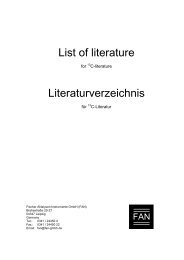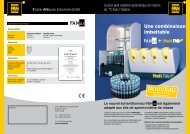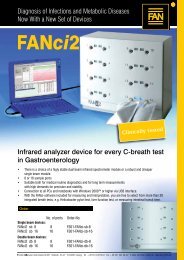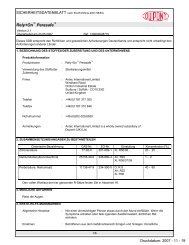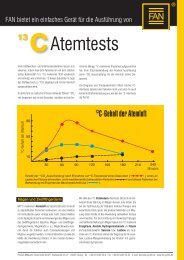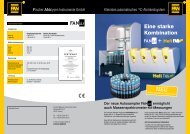Evaluation of the HeliFAN Plus Instrument General ... - FAN GmbH
Evaluation of the HeliFAN Plus Instrument General ... - FAN GmbH
Evaluation of the HeliFAN Plus Instrument General ... - FAN GmbH
You also want an ePaper? Increase the reach of your titles
YUMPU automatically turns print PDFs into web optimized ePapers that Google loves.
<strong>General</strong><br />
<strong>Evaluation</strong> <strong>of</strong> <strong>the</strong> <strong>Heli<strong>FAN</strong></strong> <strong>Plus</strong> <strong>Instrument</strong><br />
Metabolic Solutions compared <strong>the</strong> Fischer HeliFan <strong>Plus</strong> <strong>Instrument</strong> against two gas isotope ratio<br />
mass spectrometers (Europa Scientific 20-20 and Finnigan BreathMAT <strong>Plus</strong>). Samples were <strong>of</strong><br />
two types. First, gas standards made up to specific 13 C delta per mil values were utilized for <strong>the</strong><br />
evaluation <strong>of</strong> accuracy. These gas standards had 5% CO2 gas with <strong>the</strong> balance nitrogen gas.<br />
Secondly, breath samples collected during several different breath tests were analyzed by both<br />
types <strong>of</strong> instruments. In order to have identical duplicate breath samples, breath was initially<br />
collected into a 0.75 liter collection bag (Fischer Analysen <strong>Instrument</strong>e). A 10 ml sample <strong>of</strong> this<br />
breath collection was transferred under vacuum to an Exetainer tube (Labco, Ltd). The remaining<br />
breath sample in <strong>the</strong> collection bag was evaluated by <strong>the</strong> <strong>Heli<strong>FAN</strong></strong> instrument while <strong>the</strong> Exetainer<br />
tube was evaluated by <strong>the</strong> isotope ratio mass spectrometers.<br />
The <strong>Heli<strong>FAN</strong></strong> instrument was evaluated for accuracy, precision, memory carryover and clinical<br />
evaluation <strong>of</strong> breath test results.<br />
Accuracy<br />
Four different gas standards were utilized in this evaluation. The accuracy <strong>of</strong> <strong>the</strong> difference<br />
between standards was evaluated. Each gas standard was analyzed four times. The mean<br />
difference between <strong>the</strong> <strong>Heli<strong>FAN</strong></strong> and <strong>the</strong> isotope ratio instruments was –0.91 delta per mil with a<br />
standard deviation <strong>of</strong> 0.78 delta per mil. The range <strong>of</strong> differences was –1.89 to 0.81 delta per mil.<br />
We conclude that <strong>the</strong> accuracy <strong>of</strong> <strong>the</strong> <strong>Heli<strong>FAN</strong></strong> instrument is excellent and sufficient for breath<br />
test measurements.<br />
Eleven breath samples were analyzed in triplicate on both types <strong>of</strong> instruments. The mean<br />
difference between <strong>the</strong> <strong>Heli<strong>FAN</strong></strong> and <strong>the</strong> isotope ratio instruments was 0.53 delta per mil with a<br />
standard deviation <strong>of</strong> 1.04 delta per mil. The accuracy <strong>of</strong> <strong>the</strong> <strong>Heli<strong>FAN</strong></strong> instrument improved with<br />
breath samples. This was expected since <strong>the</strong> instrument’s spectroscopy is optimized with this<br />
type <strong>of</strong> sample.<br />
Precision<br />
Four baseline (without isotope administration) breath samples were analyzed in quadruplicate on<br />
<strong>the</strong> same day. The 13 C delta per mil results are shown below:<br />
Collection 1 Collection 2 Collection 3 Collection 4<br />
-19.94 -19.43 -19.87 -20.33<br />
-20.59 -19.68 -19.91 -20.04<br />
-20.55 -19.70 -20.03 -20.19<br />
-20.88 -19.78 -20.00 -20.25<br />
Mean -20.49 -19.65 -19.95 -20.20<br />
SD 0.40 0.15 0.08 0.12<br />
There is excellent precision within and between samples. The <strong>Heli<strong>FAN</strong></strong> instrument is precise to<br />
measure breath samples.<br />
Memory Effect<br />
The effect <strong>of</strong> one breath sample on <strong>the</strong> next sample can result if isotope memory exists. Two gas<br />
standards differing by about 20 per mil will analyzed by <strong>the</strong> <strong>Heli<strong>FAN</strong></strong> instrument, <strong>the</strong> low 13 C gas<br />
followed by <strong>the</strong> high 13 C gas. If <strong>the</strong>re is a memory effect, we would observe a change in <strong>the</strong> delta<br />
per mil and standard deviation <strong>of</strong> <strong>the</strong> measurements. These results are shown below:<br />
Metabolic Solutions, Inc., October 30, 2001 Page 1 <strong>of</strong> 2
Analysis Control Gas 1 Control Gas 2<br />
1 -38.09 -18.79<br />
2 -37.76 -18.46<br />
3 -38.14 -18.93<br />
4 -37.76 -18.10<br />
5 -38.17 -18.33<br />
Mean -37.98 -18.52<br />
SD 0.21 0.34<br />
We observed no measurable memory effect in typical 13 C ranges with breath tests.<br />
Clinical Breath Testing<br />
The <strong>Heli<strong>FAN</strong></strong> instrument was compared to isotope ratio mass spectrometers using several breath<br />
tests in development at Metabolic Solutions. These are <strong>the</strong> results observed:<br />
a) Gastric Emptying – An 13 C-octanoate labeled meal was used with 16 breath sample<br />
collections. The gastric emptying rate,T1/2, was calculated using all <strong>the</strong> collection points<br />
with isotope ratio analysis and <strong>Heli<strong>FAN</strong></strong> analysis.<br />
T1/2 Isotope Ratio = 161.6 minutes<br />
T1/2 <strong>Heli<strong>FAN</strong></strong> = 161.6 minutes<br />
Difference = 0.00 minutes<br />
b) Acetate Metabolism<br />
A small dose <strong>of</strong> 1- 13 C-acetate was administered to a subject. The cumulative percent<br />
recovery <strong>of</strong> 13 C in <strong>the</strong> breath over 2 hours was determined.<br />
Cum. % Dose Recovered IRMS = 14.69%<br />
Cum. % Dose Recovered <strong>FAN</strong> = 13.66%<br />
Difference = 1.03%<br />
c) Glucose Metabolism<br />
A small dose <strong>of</strong> 13 C6-glucose was administered to a subject. The cumulative percent<br />
recovery <strong>of</strong> 13 C in <strong>the</strong> breath over 2 hours was determined.<br />
Cum. % Dose Recovered IRMS = 15.96%<br />
Cum. % Dose Recovered <strong>FAN</strong> = 14.26%<br />
Difference = 1.70%<br />
d) Amino Acid Metabolism<br />
A small dose <strong>of</strong> a 1- 13 C-amino acid was administered to a subject. The cumulative<br />
percent recovery <strong>of</strong> 13 C in <strong>the</strong> breath over 2 hours was determined.<br />
Cum. % Dose Recovered IRMS = 9.66%<br />
Cum. % Dose Recovered <strong>FAN</strong> = 9.60%<br />
Difference = 0.06%<br />
These results demonstrate a good correlation between isotope ratio mass spectrometry and <strong>the</strong><br />
<strong>Heli<strong>FAN</strong></strong> instrument.<br />
Summary<br />
We conclude that <strong>the</strong> <strong>Heli<strong>FAN</strong></strong> instrument provides accurate and precise breath testing results as<br />
compared to isotope ratio mass spectrometry. The difference in <strong>the</strong> 13 C results detected by each<br />
instrument will not be meaningful in clinical practice.<br />
Metabolic Solutions, Inc., October 30, 2001 Page 2 <strong>of</strong> 2




